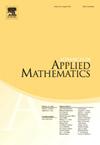On the average number of cycles in conjugacy class products
IF 1.3
3区 数学
Q3 MATHEMATICS, APPLIED
引用次数: 0
Abstract
We show that for the product of permutations from two fixed point free conjugacy classes, the average number of cycles is always very similar. Specifically, our main result is that for a randomly chosen pair of fixed point free permutations of cycle types α and β, the average number of cycles in their product is between and , where is the harmonic number.
共轭类积的平均循环数
证明了两个无不动点共轭类的置换乘积的平均循环数总是非常相似的。具体地说,我们的主要结果是,对于随机选择的一对循环类型为α和β的不动点自由排列,它们乘积中的平均循环数介于Hn−3和Hn+1之间,其中Hn为调和数。
本文章由计算机程序翻译,如有差异,请以英文原文为准。
求助全文
约1分钟内获得全文
求助全文
来源期刊

Advances in Applied Mathematics
数学-应用数学
CiteScore
2.00
自引率
9.10%
发文量
88
审稿时长
85 days
期刊介绍:
Interdisciplinary in its coverage, Advances in Applied Mathematics is dedicated to the publication of original and survey articles on rigorous methods and results in applied mathematics. The journal features articles on discrete mathematics, discrete probability theory, theoretical statistics, mathematical biology and bioinformatics, applied commutative algebra and algebraic geometry, convexity theory, experimental mathematics, theoretical computer science, and other areas.
Emphasizing papers that represent a substantial mathematical advance in their field, the journal is an excellent source of current information for mathematicians, computer scientists, applied mathematicians, physicists, statisticians, and biologists. Over the past ten years, Advances in Applied Mathematics has published research papers written by many of the foremost mathematicians of our time.
 求助内容:
求助内容: 应助结果提醒方式:
应助结果提醒方式:


